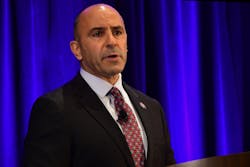Congressman Jimmy Panetta: Microgrids to Move to Front Line of Climate Fight
Microgrids are not just a revolution in the US, but a reality across the globe, said California Congressman Jimmy Panetta (D-Carmel Valley) in the keynote speech at Microgrid California, a one-day event held yesterday in the San Francisco Bay Area and organized by Microgrid Knowledge.
Panetta thanked conference participants for being on the front lines of the fight for microgrids.
“As we continue to fight climate change, your efforts are going to move to the front lines of that fight. So thank you. Thank you for continuing the fight and thank you for all you have done for making microgrids not just a revolution in our country, but a reality across the globe,” he said at the sold-out event.
During his speech, Panetta identified many ways that microgrids can help: providing resilience during public safety power shutoffs (PSPS), helping universities and colleges shrink their carbon footprints and keep the lights on, allowing the military to enjoy reliable power and bolster its cybersecurity, ensuring hospitals keep patients safe, avoiding airport outages that can wreak havoc, and providing clean water during power shutoffs.
Panetta also outlined ways that the federal government can support the deployment of microgrids, naming tax credits and grants as two important options. He also described the bill (H.R. 2482) he introduced that’s designed to increase the deployment of microgrids in California and other areas by making them more affordable. The bill is called the Making Imperiled Communities Resistant to Outages with Generation that is Resilient, Islandable and Distributed Act, or MICROGRID Act.
Act would give microgrids clear advantage
If passed, the bill would provide a 30% tax credit for new 4-kW to 50-MW microgrids through the year 2025. The credit would decrease each year until 2028 when it would be 10%. The tax credit would expire in 2029.
”When combined with credits proposed for stand-alone energy storage and credits for clean energy generation, the law would make clean energy microgrids a clear advantage over dirtier backup fuels and help our communities rethink our reliance on unstable grids,” he said.
Disasters due to climate change were an important focus of Panetta’s speech.
“Clearly we are facing challenging times, especially as we see here in California, climate change is impacting our daily lives,” said Panetta, naming as examples wildfires in the West and related PSPS events, the February freeze in Texas, and Hurricane Ida and its destruction in Louisiana.
For example, Ida reportedly damaged or destroyed more than 12,000 poles and 770 miles of power distribution equipment, causing 1 million customers to lose power, he said.
“It’s those types of extreme weather events that prove that our power grid is unreliable, which makes us very, very vulnerable,” said Panetta. Even though the US is adding renewable energy and battery storage, when the grid goes down, citizens’ lives and livelihoods are interrupted, he said.
“So that’s why we need solutions to remove the instability of large interconnected grids,” said Panetta. “That’s why we need microgrids.” Microgrids are different from other forms of distributed energy resources (DER) because they’re capable of islanding from the grid.
Microgrids’ controllers help set them apart from other DERs because they manage the dispatch of energy resources, he added.
“Microgrids are not just being talked about in this valley. They’re actually being talked about in Washington, D.C., and what we’re seeing is microgrids popping up all across this country,” he said.
Embracing microgrids
One example is college campuses, which are increasingly looking into microgrids to provide reliability — especially if they’re involved in electricity-dependent research and development.
And hospitals are adding microgrids to ensure that patients receive the care they need, Panetta said. For example, Kaiser Permanente is demonstrating a range of microgrid technologies in Ontario, California, showing that hospitals can incorporate solar and storage to move away from diesel as backup power.
The military has also embraced microgrids, he said. For example, a $21.6 million project at Fort Hunter Liggett in Jolon, California, aims to boost energy security by separating the base from vulnerable external systems in the event of a power outage on the grid. The microgrid will help the base move toward its goal of achieving net-zero energy by 2022.
“The Department of Defense supports such projects because they know how important microgrids are to our national security,” said Panetta. “The Pentagon is not only concerned about outages from climate change and extreme weather. They are also legitimately concerned and threatened by cyberattacks and hacking into major energy generation and transmission facilities.”
Public agencies are also jumping on the microgrid trend, he said. One California example, Panetta said, is the Metropolitan Water District of Southern California, which is building microgrids at three water treatment plants and a pumping station. The goal is to provide clean drinking water during power outages.
And more and more transportation related agencies are embracing microgrids, Panetta said. He offered as an example the New Jersey Transit Authority, which is looking into microgrids to improve light rail reliability. And the Pittsburgh International Airport has built a microgrid so that outages don’t disrupt flights.
“The last thing anybody wants is a repeat of that 11-hour power outage at Hartsfield Jackson airport in Atlanta that canceled 1,200 flights and caused tens of millions of dollars in damages,” said Panetta.
California’s pursuit of microgrids
In his own district on California’s central coast, a number of projects are demonstrating the benefits of microgrids, he said. The Central Coast Community Energy, a community choice aggregation, is deploying microgrids to boost reliability and promote economic development.
And the city of Gonzales, California, which lost power for three days because of a PSPS, decided to create a microgrid project to protect the town and its agricultural community, he said.
“And that means our food security. Gonzales is in the heart of the salad bowl of the world,” Panetta said.
In addition to providing details about numerous microgrid projects, Panetta outlined some of the details of his microgrid bill, saying that it uses the power of tax credits to move the microgrid industry forward.
Under the bill, tax-exempt organizations can take advantage of the credit, even if they don’t have tax liability. They can receive direct payments instead of credits, he said.
As a member of the Ways and Means Committee that has jurisdiction over the tax code, he has seen the power of tax credits, said Panetta. Federal tax credits helped the solar and wind industry become competitive with fossil fuels. They’ll also give the microgrid industry a big boost.
“I can tell you that I’m very confident that we have made a clear case for the Microgrid Act, and that microgrids continue to be instrumental tools for our climate resiliency and for the fight against climate change,” he said.
Track news about the MICROGRID Act. Subscribe to the free Microgrid Knowledge Newsletter.








